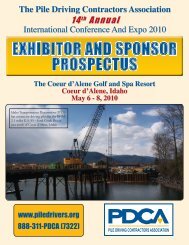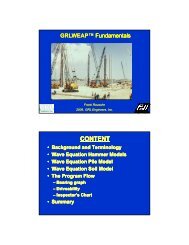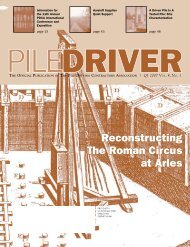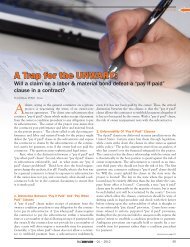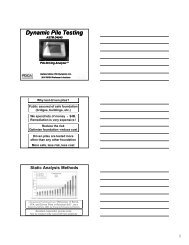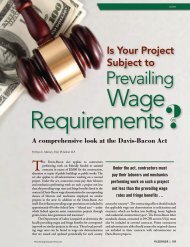Full Issue (17 MB) - Pile Driving Contractors Association
Full Issue (17 MB) - Pile Driving Contractors Association
Full Issue (17 MB) - Pile Driving Contractors Association
Create successful ePaper yourself
Turn your PDF publications into a flip-book with our unique Google optimized e-Paper software.
VI-RO spinning machine. This process involves placing zero<br />
slump concrete in layers in a steel form barrel while spinning<br />
the form barrel at a low revolution speed. Revolution speed is<br />
high enough that concrete being charged into the form moves<br />
to the sides of the form by centrifugual force but slow enough<br />
to allow the safe placement of concrete in the form. After filling<br />
the form with the required volume of concrete, the revolution<br />
speed is increased to allow compaction of the concrete.<br />
Strict quality control standards were followed with four<br />
test cylinders made for every 10 pile sections produced. Two<br />
cylinders are immediately transported to the lab to cure in<br />
accordance to AASHTO T-23 standards. These two cylinders<br />
are broken at age 28 day. The two remaining cylinders are<br />
match cured with the pile sections. One is broken at the end<br />
of the steam curing cycle and one cylinder is broken at the age<br />
of 7 days to verify that the section has achieved tensioning<br />
strength.<br />
Upon completion of the spinning cycle each pile section<br />
is steam cured in a kiln at a minimum of three hours at temperatures<br />
from 130° minimum and 180° maximum. They are<br />
stored for the final curing period and reach a 28-day strength<br />
of not less than 7,000 psi.<br />
The full length cylinder piles are then assembled from<br />
the pile sections. <strong>Pile</strong> sections are placed on “lay down” racks<br />
where they are inspected. The post tensioning<br />
tendon core holes are aligned<br />
and two ½” diameter, 270 ksi low relaxation<br />
strands are installed in each core<br />
hole. Ends of the pile sections are “buttered”<br />
with polyester resin. Sections are<br />
butted together and become a single<br />
unit by stressing with hydraulic jacks.<br />
The strands are stressed to a predetermined<br />
202,500 ksi.<br />
Once the stressing is finished and<br />
after the joint compound has set, the<br />
tendon holes are grouted with a mixture<br />
of cement and water. The grout is<br />
64 • Q4 • 2009





